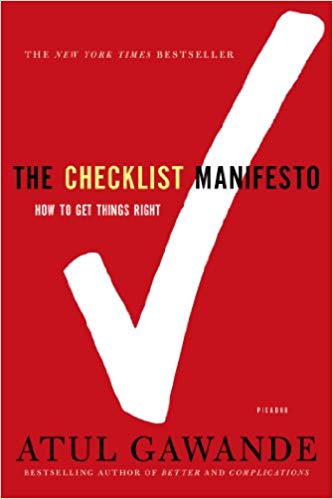

This article is an excerpt from the Shortform summary of "The Checklist Manifesto" by Atul Gawande. Shortform has the world's best summaries of books you should be reading.
Like this article? Sign up for a free trial here .
What are the two most powerful and effective types of checklists? How do you create them to increase your efficiency and avoid careless mistakes?
We’ll cover the two types of checklists–the Do-Confirm and the Read-Do–and discuss how to decide which one is right for you and your situation.
2 Powerful Types of Checklists
Before creating a checklist, decide two things:
1) Decide whether to create a Do-Confirm list or a Read-Do list.
The Do-Confirm list and the Read-Do list are the two most powerful types of checklists.
To use a Do-Confirm checklist, team members perform their jobs from memory. Then they stop and go through the checklist and confirm that they completed every item on the checklist. In contrast, to use a Read-Do checklist, people carry out each task as they check it off, like a recipe.
(Shortform note: Choose the type of checklist that makes the most sense for the situation. For instance, a Read-Do list could be used when the sequence needs to be exact or the entire effort will fail, like in operating machinery or listing emergency tasks. A Do-Confirm list gives more freedom and is allowable when the stakes are lower, and a forgotten step can be done later out of sequence.)
Both types of checklists are good choices, but they need to be appropriate for the situation. After you’ve chosen one of the two types of checklists, move on to step #2.
2) Define a clear ‘“pause point” at which the checklist is to be used (unless the moment is obvious, such as when something malfunctions).
Tips for Creating Your Type of Checklist
Once you’ve chosen which type of checklist you’re creating, follow these guidelines:
- Keep the checklist short, typically five to nine items, which is the limit of short-term memory. After 60 to 90 seconds, a checklist becomes a distraction from other things. People are likely to skip or miss steps.
- Focus on the “killer” items or steps that are most dangerous to miss but that are still sometimes overlooked.
- Remember that checklists are not supposed to be how-to guides. They are quick, simple tools to aid the recall of experts.
- Keep wording simple and exact.
- Use language and terminology familiar to the user.
- Fit the checklist on one page.
- Avoid clutter and unnecessary or distracting colors.
- Use upper and lowercase text in a sans serif font for ease of reading.
Test your type of checklist in the real world — have people use it and provide feedback. Boorman tests his checklists in a flight simulator. Language that you think is clear may not be to someone else. In practice, things are always more complicated than anticipated. Keep revisiting and testing the checklist until it works consistently.
Why Pilots Trust Checklists
Some of the most effective types of checklists come from the world of aviation. Pilots readily turn to checklists because they’re trained to do so, from the beginning of flight school. They know their memory and judgment are fallible, and that lives depend on their recognizing that fact.
They also know that these types of checklists have proven their worth and don’t hesitate to turn to them in emergencies. For example, pilots turned to a checklist and saved lives in 1989 when a forward cargo door blew out on a flight from Honolulu to New Zealand, and flying debris damaged a wing and two engines. In under two seconds, nine passengers were sucked from the plane and lost at sea.
The pilots didn’t know what had happened — they thought a bomb had gone off — but they knew cabin pressure and oxygen had dropped. Voice recordings show that they immediately turned to a checklist. Following protocol, they reduced altitude, shut down the two damaged engines, tested the plane’s ability to land with wing damage, dumped fuel to lighten their load, and safely returned to Honolulu with 328 remaining passengers and 18 crew members.
As another example, in 2008, the engines gave out on a British Airways flight from China when it was only two miles from London Heathrow Airport. The pilots crash-landed the Boeing 777 at 124 miles per hour in a grassy field a quarter-mile short of the runway, but everyone survived.
The cause wasn’t provable, but investigators theorized that ice crystals had formed in the fuel lines as the plane flew over extremely cold regions. Boorman’s Boeing team created a checklist of new procedures for dealing with a fuel blockage caused by ice crystals, and within a month it was in the hands of pilots and in cockpit computers.
Later that same year, it was put into action, when a Delta flight from Shanghai to Atlanta had engine failure over Great Falls, Montana, due to ice in the fuel lines. Pilots followed their checklist, slowing instead of revving the engine to give it time to recover, and 247 people were saved. There are clear advantages to using these types of checklists.
A Lesson for Medicine
While Boorman and his team at Boeing quickly got new information into a useful form and out to the people who needed it, the field of medicine is notoriously slow to put new information into action.
A study following nine new treatment discoveries showed that on average it took doctors 17 years to adopt new treatments for at least half of American patients. When it comes to errors, medical professionals don’t typically conduct investigations the way aviation investigators do. And even if they do investigate a failure and learn something, they might issue voluminous guidelines unlikely to be read, make an addition to a textbook, or mention the new information in a seminar.
The knowledge basically doesn’t get out because it hasn’t been put into a simple, usable form and distributed systematically. The world of medicine is in need of effective types of checklists.
Creating These Types of Checklists
Creating these types of checklists involves three phases, each with key steps, including the following.
Development
Establish clear, concise objectives. Each task you include should be:
- A critical safety step that is easily missed.
- A step not covered by other means.
- Actionable, requiring a specific response.
- Designed to be read aloud.
Also, include items to improve communication among team members. Involve team members in creating these types of checklists.
Drafting
These types of checklists should:
- Use logical breaks in the workflow (pause points). There should be fewer than ten items per pause point.
- Use simple sentences and language.
- Have a title reflecting its objectives.
- Have a simple, uncluttered, and logical format.
- Fit on one page.
- Minimize the use of color.
- List the date of creation or latest revision.
The text should be:
- Sans serif.
- Upper and lower case.
- Large enough to be read easily.
- Dark on a light background.
Finalizing
- Test the type of checklist with front-line users (in either a real or simulated situation).
- Revise it in response to repeated trial runs.
- Make sure it fits the workflow.
- Ensure the type of checklist can be run in a relatively short amount of time.
- Plan for regular review and revision.
———End of Preview———

Like what you just read? Read the rest of the world's best summary of "The Checklist Manifesto" at Shortform . Learn the book's critical concepts in 20 minutes or less .
Here's what you'll find in our full The Checklist Manifesto summary :
- How checklists save millions of lives in healthcare and flights
- The two types of checklists that matter
- How to create your own revolutionary checklist






